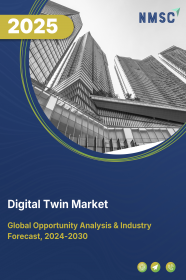
Digital Twin Market by Type (System Digital Twin, Product Digital Twin, Process Digital Twin), by Application (Product Design & Development, Predictive Maintenance, Business Optimization, Performance Monitoring, Inventory Management, and Others), and by End-Users (Automotive & Transportation, Energy & Utilities, Infrastructure, Healthcare, Aerospace, Oil & Gas, Telecommunications, Agriculture, Retail, and Others) - Global Opportunity Analysis and Industry Forecast 2023-2030
Market Definition
The global Digital Twin Market size was valued at USD 9.96 billion in 2022 and is predicted to reach USD 195.85 billion by 2030 with a CAGR of 45.1% from 2023-2030. A digital twin refers to a virtual representation of a real-world physical object, system, or process. It involves the creation of a digital counterpart that mirrors the physical entity in terms of its attributes, behaviors, and interactions.
This digital representation is continuously updated in real-time through data collected from sensors, IoT devices, and other sources. Digital twins enable the monitoring, analysis, and simulation of the physical entity's performance, allowing for insights, predictions, and optimizations to be made, ultimately enhancing decision-making, efficiency, and innovation across various industries.
Market Dynamics and Trends
The increasing demand for connected devices and the adoption of IoT technologies are driving the growth of the global market. Digital twin technology is being used to optimize the performance of IoT devices and improve their efficiency. Moreover, the increasing use of digital twin technology in healthcare to simulate treatments, anticipate health problems, and minimize the need for repetitive tests and interventions is significantly fueling the digital twin market growth.
In addition, the increasing use of simulation and modeling tools in product design and development is propelling the growth of the digital twin market. Digital twin technology enables designers and engineers to simulate different scenarios and optimize product performance, which can lead to faster time-to-market, reduced costs, and improved product quality.
However, implementing digital twin technology involves significant upfront costs, including acquiring advanced sensors, IoT devices, data analytics tools, and the necessary infrastructure for data collection and processing. This financial barrier can deter some organizations, especially smaller businesses, from adopting digital twins, thus restraining the growth of the market.
On the contrary, the increasing implementation of advanced technologies such as artificial intelligence (AI), machine learning (ML), augmented reality (AR), virtual reality (VR), and digital twins across various industries such as aerospace and automotive is expected to create ample growth opportunities for the market in the future.
Market Segmentations and Scope of the Study
The digital twin market is segmented on the basis of type, application, end user and geography. On the basis of type, the market is divided into system digital twin, product digital twin, and process digital twin. On the basis of application, the market is categorized into product design & development, predictive maintenance, business optimization, performance monitoring, inventory management, and others. On the basis of end user, the market is segmented into automotive & transportation, energy & utilities, infrastructure, healthcare, aerospace, oil & gas, telecommunications, agriculture, retail, and others. Geographic breakdown and analysis of each of the aforesaid segments includes regions comprising of North America, Europe, Asia-Pacific, and RoW.
Geographical Analysis
North America holds the dominant share of digital twin market at present and is expected to continue its dominance during the forecast period. This is due to the rising demand for improved efficiency and effectiveness in military operations and maintenance in this region.
For instance, in August 2022, the U.S. Army Aviation company collaborated with Wichita State University's National Institute for aviation research to develop an Apache Digital Twin. This development aims to bring Army Aviation sustainment into the digital age by giving commanders and soldiers the tools needed to build & maintain combat power in the combat aviation brigades efficiently and effectively.
Also, the presence of key market players such as IBM Corporation, Microsoft Corporation, General Electric and ANSYS Inc. that are adopting various market strategies including partnership is further accelerating the market growth. For instance, in March 2022, Microsoft partnered with Newcresty an Australia based resources company, to drive digital transformation initiatives by focusing on utilizing Microsoft's technology, including digital twin solutions, to enhance Newcrest's mining operations. The partnership highlights the role of digital twins in revolutionizing traditional industries, demonstrating how technology can optimize processes and drive innovation in sectors like mining.
On the other hand, Asia-Pacific is expected to show a steady rise in the digital twin market due to the developed automotive industry in countries such as China and Japan. According to the International Trade Administration, China continues to be the world’s largest vehicle market by both annual sales and manufacturing output, with domestic production expected to reach 35 million vehicles by 2025. Digital twins enable precise simulation, analysis, and optimization of manufacturing processes, product design, and performance testing. This results in streamlined operations, improved product quality, and reduced time-to-market for automotive companies.
Moreover, government initiatives aimed at fostering technological innovation and digital transformation are significantly fueling the growth of the digital twin market. For instance, in February 2022, the Union Minister of State Science & Technology (India) launched the pan-India 3D Maps Program by Genesys. This program was based on the concept of the digital twin and enabled the creation of a strong foundation for urban planning & operations.
Competitive Landscape
The digital twin industry comprises of various market players such as Autodesk Inc., Accenture plc, Oracle Corporation, Robert Bosch, ANSYS Inc., Schneider Electric, Siemens AG, IBM Corporation, Rockwell Automation Inc., Bentley systems, ABB Group, General Electric Co., Microsoft Corporation, Hitachi Ltd., and Dassault Systems SE. These market players are adopting various strategies such as collaboration and product launches across various regions to maintain their dominance in the global market.
For instance, in October 2022, Microsoft collaborated with Capgemini to offer a cloud-native digital twin solution, aiding organizations in reimagining their operations. This collaboration combines Capgemini's expertise in digital transformation with Microsoft's cloud technology to create innovative digital twin solutions. The partnership highlights the growing importance of digital twins in optimizing operations, enhancing efficiency, and fostering innovation across various industries.
Also, in March 2021, ANSYS Inc. collaborated with Ansys, a major engineering simulation software provider, to expedite the development of zero-carbon energy solutions. By leveraging Ansys' simulation tools, ENGIE Lab CRIGEN aims to enhance the efficiency and effectiveness of their renewable energy and sustainable technology projects. This partnership demonstrates the role of technology collaborations in advancing zero-carbon energy initiatives, highlighting the significance of digital twin technology in optimizing and accelerating the evolution of sustainable energy solutions.
Moreover, in February 2021, Autodesk Inc. launched a new virtual twin tool named as ‘Autodesk Tandem’ that aimed to streamline the flow of real-time data for the architecture, engineering & construction (AEC) industry. This tool assist project owners in creating a twin technology model to optimize their operations.
Key Benefits
-
The report provides quantitative analysis and estimations of the digital twin market from 2023 to 2030, which assists in identifying the prevailing market opportunities.
-
The study comprises a deep-dive analysis of the digital twin market including the current and future trends to depict prevalent investment pockets in the market.
-
Information related to key drivers, restraints, and opportunities and their impact on the global market is provided in the report.
-
Competitive analysis of the players, along with their market share is provided in the report.
-
SWOT analysis and Porters Five Forces model is elaborated in the study.
-
Value chain analysis in the market study provides a clear picture of roles of stakeholders.
Key Segments
By Type
-
System Digital Twin
-
Product Digital Twin
-
Process Digital Twin
By Application
-
Product Design & Development
-
Predictive Maintenance
-
Business Optimization
-
Performance Monitoring
-
Inventory Management
-
Others
By End User
-
Automotive & Transportation
-
Energy & Utilities
-
Infrastructure
-
Healthcare
-
Aerospace
-
Oil & Gas
-
Telecommunications
-
Agriculture
-
Retail
-
Others
By Region
-
North America
-
US
-
Canada
-
Mexico
-
-
Europe
-
UK
-
Germany
-
France
-
Italy
-
Spain
-
Denmark
-
Netherlands
-
Finland
-
Sweden
-
Norway
-
Russia
-
Rest of Europe
-
-
Asia-Pacific
-
China
-
Japan
-
India
-
South Korea
-
Australia
-
Indonesia
-
Singapore
-
Taiwan
-
Thailand
-
Rest of Asia-Pacific
-
-
RoW
-
Latin America
-
Middle East
-
Africa
-
Report Scope and Segmentation
|
Parameters |
Details |
|
Market Size in 2022 |
USD 9.96 Billion |
|
Revenue Forecast in 2030 |
USD 195.85 Billion |
|
Growth Rate |
CAGR of 45.1% from 2023 to 2030 |
|
Analysis Period |
2022–2030 |
|
Base Year Considered |
2022 |
|
Forecast Period |
2023–2030 |
|
Market Size Estimation |
Billion (USD) |
|
Growth Factors |
Increasing adoption of connected devices and IoT technologies. Growing use of digital twin technology in healthcare to simulate treatments fuels market growth |
|
Countries Covered |
28 |
|
Companies Profiled |
15 |
|
Market Share |
Available for 10 companies |
|
Customization Scope |
Free customization (equivalent up to 80 working hours of analysts) after purchase. Addition or alteration to country, regional, and segment scope. |
|
Pricing and Purchase Options |
Avail customized purchase options to meet your exact research needs. |
KEY PLAYERS
-
Autodesk Inc
-
Accenture plc
-
Oracle Corporation
-
Robert Bosch
-
ANSYS Inc.
-
Schneider Electric
-
Siemens AG
-
IBM Corporation
-
Rockwell Automation Inc.
-
Bentley systems
-
ABB Group
-
General Electric Co.
-
Microsoft Corporation
-
Hitachi Ltd.
-
Dassault Systems SE




















 Speak to Our Analyst
Speak to Our Analyst

























